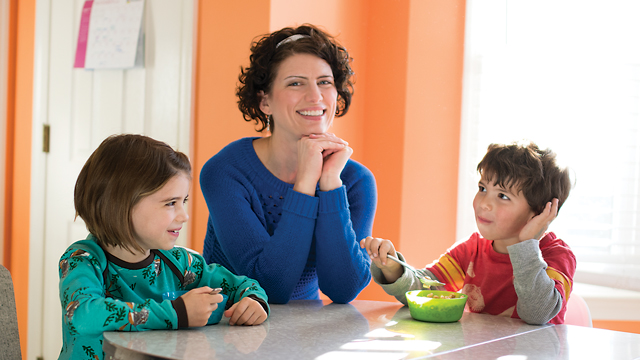I used to be a parenting expert. Then I had children. Back when I knew everything, I swore that my children would never touch anything containing Yellow No. 5 or high-fructose corn syrup. They would never slurp their fruit directly from a pouch, or eat anything festooned with a licensed character. No, my kids would pack quinoa in reusable containers, snack on kale chips sprinkled with sea salt, and sup on salmon ceviche. Of course, we would enjoy the occasional pizza night – featuring fresh pesto made from homegrown basil.
As it turns out, I do look forward to pizza night: It’s the one night of the week everyone at the table actually sits and eats the same meal. We had pizza last night, but, unfortunately, there wasn’t a dollop of pesto in sight. And it wasn’t delivery, it was…well, you know the rest.
Because I was raised by a single mother who worked outside the home, my brother and I ate dinner most nights at my grandparents’ house. As products of the Great Depression, they wasted nothing (my granddad’s end-of-the-week soups could be pretty interesting). I ate what they served, when they served it, and though I can’t say I enjoyed everything, there are very few foods I refused to eat. Despite my best efforts – including extended breastfeeding and baby-led weaning – my own children (a daughter who is seven, and a son, age four) are not adventurous eaters. My daughter enjoys a variety of fruits, veggies, and proteins, though she prefers these foods to be cooked separately and unseasoned, but my son takes picky eating to new levels. At one point, I could count on one hand the number of foods he would actually eat. As I struggled to find a solution to his picky eating, I saw the same tips offered up over and over. Here’s how these bits of advice worked out for us.
1. They’ll eat when they’re hungry.
No, they won’t. But they will wake up at five in the morning demanding cereal.
2. Kids who help grow and prepare their food will be more likely to try it.
Sounds fun! Let’s try it! As it turns out, digging in the dirt and operating the food processor are their own reward. My son would just as soon eat the hubcaps of the car he helped wash as he would eat ratatouille containing tomatoes he planted, harvested, and stirred into a pot. Exception: He would happily eat raw cookie dough. And if I thought I could sneak zucchini into raw cookie dough, I would totally let him. Which leads me to the next bit of advice…
3. Conceal puréed vegetables in foods your child likes.
Before you try this tactic, be aware that you run the risk of transferring an accepted food to the does not eat list, and, like the waters of a mighty river or the passage of time itself, the flow between these lists happens in one direction only.
4. You can make homemade alternatives to prepackaged and fast food items.
It’s fairly easy to construct something resembling a Lunchable, and Pinterest is full of recipes for Chick-fil-A nugget hacks, but your kids know the difference and that’s no accident: The fast food industry spends nearly two billion dollars marketing its nutritionally devoid products to children. Your $2 star-shaped cookie cutter doesn’t stand a chance against Big Nugget.
5. Before it is accepted, you might have to offer a new food up to fifteen times.
Let’s do the math: twelve months in a year, thirty days in a month, one baby carrot on the plate every day since age one. I would say I’ve probably offered my son carrots somewhere in the neighborhood of a thousand times. He eventually came to accept them as a garnish, which is actually an improvement from their previous status as projectile.
6. Serve brightly colored food in fun arrangements.
Fresh fruit carefully arranged to resemble a rainbow is still a pile of fruit (though my son enjoyed the marshmallow cloud from which the fruit rainbow sprang).
7. Don’t buy food you don’t want your child to eat, and model good eating habits for your child.
Aside from the fact that my husband is a grown-up who brings home a paycheck and does the dishes every night (Yes, I got a good one!), and is thus entitled to eat Doritos whenever he darn well feels like it, I can’t not buy cereal, milk, cheese, applesauce, and, yes, dinosaur-shaped nuggets, fish-shaped crackers, and bunny-shaped fruit snacks. I’ve got another kid who needs to eat, too, and just because one member of the family appears to be photosynthetic does not mean the rest of us have to adopt the austerity measures of 1950s East Germany.
8. Require that he take as many bites as he is years old (four years = four bites).
So do we go back and start over at zero when a bite gets regurgitated? Come to think of it, this method might be an effective weight loss technique for adults in the vicinity because it’s very hard to overeat when your dining companion is barfing on the table.
After my attempts to follow these parenting tips proved an abysmal failure (I draw the line at vomiting), I knew that something was really wrong. As it turns out, my son isn’t a “picky eater” after all. Evaluation by his pediatrician and several specialists showed that there were physical problems that had prevented him from developing normal eating habits. Rainbow-shaped fruit wasn’t going to be of much use to a kid who needed surgery, a year of weekly sessions with a feeding therapist, and ongoing occupational therapy. I’m happy to report that with the right interventions, he has made great progress and will sometimes eat his carrots. The truth is, whether your child has a diagnosed feeding disorder or is playing power games at the table, there are no easy fixes to picky eating. Progress can be slow, but when it comes to parenting concerns about feeding, eating, and food, good luck – and go with your gut.





